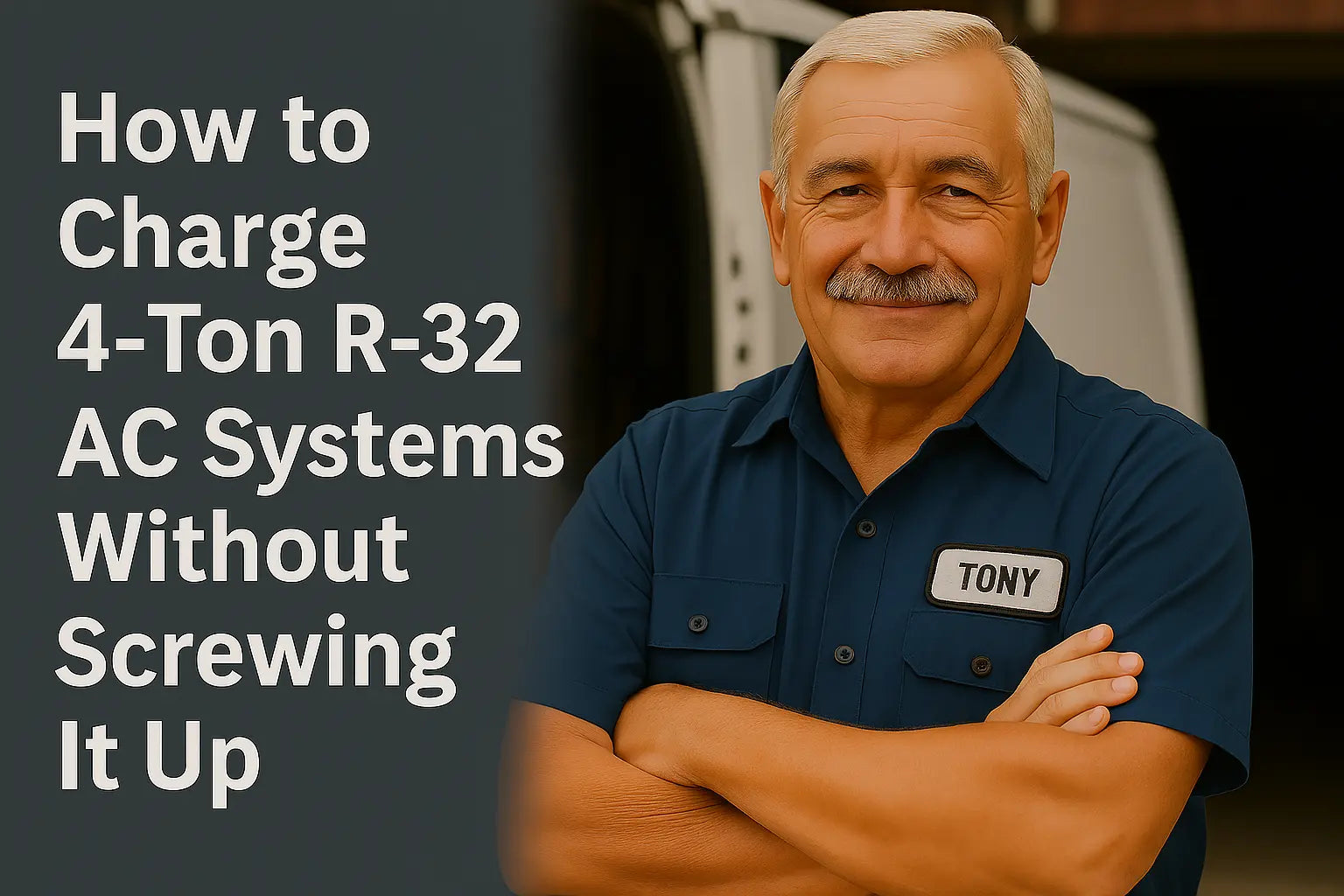Alright, Here We Go Again.
I can’t tell you how many times I’ve been called in to fix a 4-ton R-32 system that was “acting weird” — short cycling, blowing warm air, or tripping on high head pressure.
You know what 9 out of 10 of those cases had in common?
Bad charging.
Either it was overcharged by a pound, undercharged by a few ounces, or worse — "eyeballed" by a tech who thought they could beat the charts.
Listen, when you’re working with a 4-ton AC system and using R-32, you’re dealing with tight tolerances, higher operating pressure, and a refrigerant that doesn’t forgive sloppiness.
Let’s get it right. I’ll show you:
-
What tools to use
-
What mistakes to avoid
-
How to charge a 4-ton R-32 like a pro
Why 4-ton R-32 Systems are Tricky to Charge
First, let’s talk size. A 4-ton unit means you’re moving 48,000 BTUs per hour — that’s a lot of cooling, and a lot of refrigerant.
With R-32’s higher pressure, a slight mistake in your charge quantity can mean:
-
high head pressure lockouts
-
floodback and oil washout
-
short cycling
-
compressor damage
-
poor dehumidification
On top of that, 4-ton units often have:
-
longer line sets
-
bigger coils
-
multiple expansion devices (TXVs or EEVs)
-
large filter-driers and suction accumulators
These all impact charge volume. So if you’re “just topping off” without weighing it in or checking superheat/subcooling? You’re flying blind.
Get Your Tools Right
Before you even think about cracking open a refrigerant tank, you better have these on deck:
Digital manifold gauge set – Analog won’t cut it. You need accurate high/low pressure readings. I use a Fieldpiece SM380V or similar.
Refrigerant scale – No kitchen scales. Use a proper, A2L-rated refrigerant scale with gram accuracy.
Vacuum pump with core removal – Pull down to 500 microns or less, and verify with a vacuum gauge. Core removal tools are non-negotiable on big systems.
Nitrogen regulator and tank – You’ll need this for brazing and pressure testing. Nitrogen purging isn’t a “nice-to-have” on 4-ton R-32 jobs — it’s required.
A2L recovery tank – You cannot use a leftover R-410A recovery tank for R-32. You’ll need one with proper labeling and pressure ratings. Not sure what qualifies? AHRI lays it out clearly in their updated A2L refrigerant recovery and safety guidance.
Charging Procedure for 4-ton R-32 Units
Let’s go step-by-step.
Step 1: Know the factory charge
Every outdoor unit comes with a tag that says factory refrigerant charge. This is typically for 15 feet of line set.
Example:
“Pre-charged with 119 oz of R-32 for 15 ft. of 3/8” and 7/8” line.”
If you’re running a 25 ft line set, you’ll need to add additional charge — usually around 0.6 oz per foot of added tubing. But always check the manufacturer’s instructions.
A good reference for this? Trane has a detailed residential split system charging guide that works great as a baseline, even if you’re not using their equipment.
Step 2: Pull a proper vacuum
This isn’t optional on a 4-ton system. With this much refrigerant in play, moisture and non-condensables will destroy efficiency.
-
Use core removal tools
-
Pull vacuum to 500 microns or less
-
Let it sit for 10 minutes to ensure no rebound
No moisture = no compressor burnout down the road.
Step 3: Charge by weight (not pressure)
With R-32, always start by charging by weight — especially with a brand-new system or long line set.
-
Put the tank on the scale
-
Invert if needed (check tank label)
-
Open slowly to avoid shocking the system
-
Add refrigerant until the full calculated charge weight is in
Then — and only then — go to pressure testing.
Step 4: Fine-tune with superheat/subcooling
Now the real work begins. Run the system for at least 15 minutes, and check:
-
Subcooling (condenser-side) — typically 10–15°F
-
Superheat (evaporator-side) — depends on TXV or fixed orifice
Use the charging chart provided by the manufacturer. Don’t freelance. That 4-ton unit’s performance curve is tight, especially with R-32’s thermodynamic properties.
Want more depth? The team at HVAC School put together a fantastic charging guide for R-32 that breaks it down in plain English.
Top Mistakes to Avoid (Especially on 4-ton Installs)
Let me save you some callbacks. Here’s what I’ve seen kill performance:
Charging by sight glass – Not reliable with R-32. You’ll under- or overcharge it every time.
Guessing on added line set charge – Measure. Use the table. Add with precision.
Liquid into the suction line – Don’t do it. Always meter vapor into the low side slowly or use a charging cylinder.
Skipping altitude adjustments – At high elevations, pressures behave differently. Forane’s charging altitude chart is a handy tool if you’re up in the mountains.
Charging when airflow’s restricted – Dirty filters, iced coils, or blower issues? Don’t even attempt to charge until airflow’s dialed in. Need a full checklist? Energy Vanguard covers it well.
Final Thoughts from Tony
4-ton systems don’t give you much margin for error — and R-32’s higher pressure and tighter operating window make charging one a precision job.
If you’re not using a scale? You’re guessing.
If you’re not reading charts? You’re risking.
And if you’re not pulling a full vacuum? You’re gambling with a $1,500 compressor.
Don’t be that guy. Take your time, check your numbers, and charge like a technician — not a handyman.
Need a system that’s worth dialing in?
👉 Shop 4-Ton R-32 Air Conditioners at The Furnace Outlet
They’ve got the specs, the support, and the gear to back you up.
Need more troubleshooting tips? Visit my guide: Common Troubleshooting Issues with 4-Ton R-32 Systems (and How to Solve Them).
Until next time,
Keep it tight, keep it clean, and don’t forget your micron gauge.
– Tony the Trusted Tech







